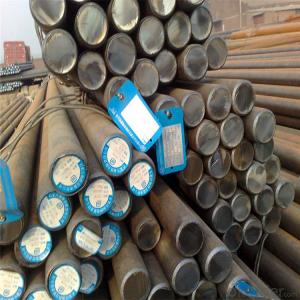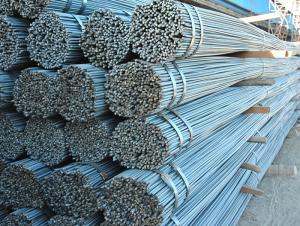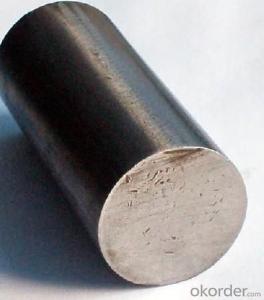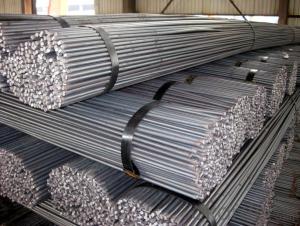C45 1045 Carbon Steel Round Bar for Machinery and Hardware Fields
- Loading Port:
- Tianjin
- Payment Terms:
- TT OR LC
- Min Order Qty:
- 100 m.t.
- Supply Capability:
- 500000 m.t./month
OKorder Service Pledge
OKorder Financial Service
You Might Also Like
Item specifice
C45 1045 Carbon Steel Round Bar for Machinery and Hardware Fields
Product Description of C45 1045 Carbon Steel Round Bar for Machinery and Hardware Fields
1. Steel grade: ASTM4140, SCM440, 42CrMo, DIN1.7225
2. Length: 6M-12M
3. Diameter: 16mm-300mm
4. Product range: round bar, flat bar, square bar
5. Technique: Hot rolled, forged, cold drawn
Specification of C45 1045 Carbon Steel Round Bar for Machinery and Hardware Fields
Material | SCM4140 | Round bar | Dia(mm) | 16-300mm |
Process | EAF + LF + VD + Forged + Heat Treatment (optional) | Length (mm) | Max 12m | |
Heat treatment | Normalized / Annealed / Quenched / tempered | Flat bar | Thickness(mm) | 8-500mm |
Delivery condition | Hot forged +Rough machined (black surface after Q/T)+ Turned (optional) | Width(mm) | 70-200mm | |
Test | Ultrasonic test according to SEP 1921-84 D/d | Length (mm) | Max 12m |
Chemical Composition of C45 1045 Carbon Steel Round Bar for Machinery and Hardware Fields
C | Si | Mn | Cr | Mo | P | S |
0.38~0.43 | 0.15~0.35 | 0.75~1.00 | 0.8~1.1 | 0.15~0.25 | ≤0.035 | <0.04< td=""> |
Photo Show of C45 1045 Carbon Steel Round Bar for Machinery and Hardware Fields
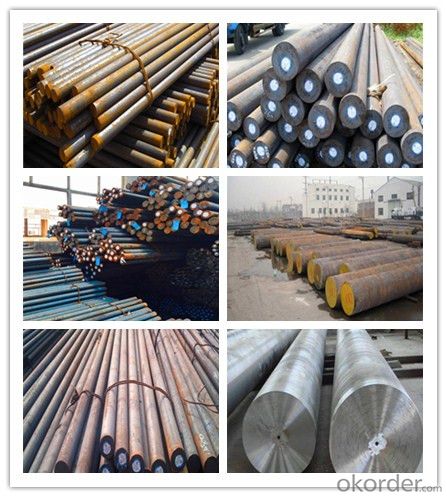
Packing and Delivery:
Packing in bundle package, or as customer's requirements.
Delivery Detail: 45 days after receiving the deposit.
Usage and Applications of C45 1045 Carbon Steel Round Bar for Machinery and Hardware Fields
1. Steel round bar is used in a large number of architectural and engineering structures. Or it can be used in construction of plants for the production of steel house frames, high-voltage transmission towers, bridges, vehicles, boilers, containers, ships, etc.
2. And we can use this kind of product on the performance of the mechanical parts if the demand is not very high.
3. Some special material steel round bar can be used for main shaft of steamer, hummer shank, with big section and supper force.
Company Information
CNBM International Corporation is the most important trading platform of CNBM group.
Whith its advantages, CNBM International are mainly concentrate on Cement, Glass, Iron and Steel, Ceramics industries and devotes herself for supplying high qulity series of refractories as well as technical consultancies and logistics solutions.


F A Q
1, Your advantages?
professional products inquiry, products knowledge train (for agents), smooth goods delivery, excellent customer solution proposale
2, Test & Certificate?
SGS test is available, customer inspection before shipping is welcome, third party inspection is no problem
3, Factory or Trading Company?
CNBM is a trading company but we have so many protocol factories and CNBM works as a trading department of these factories. Also CNBM is the holding company of many factories.
4, Payment Terms?
30% TT as deposit and 70% before delivery.
Irrevocable L/C at sight.
5, Trading Terms?
EXW, FOB, CIF, FFR, CNF
6, After-sale Service?
CNBM provides the services and support you need for every step of our cooperation. We're the business partner you can trust.
For any problem, please kindly contact us at any your convenient time.
We'll reply you in our first priority within 24 hours.
- Q:Are steel round bars suitable for bearing applications?
- Yes, steel round bars are suitable for bearing applications. They offer high strength, durability, and excellent load-bearing capabilities, making them commonly used in various industries such as automotive, construction, and machinery.
- Q:What are the different types of surface defects that can occur in steel round bars?
- There are several types of surface defects that can occur in steel round bars, including scratches, pits, roll marks, scale, and cracks.
- Q:What are the advantages of using nickel-zinc alloy steel round bars?
- Nickel-zinc alloy steel round bars offer numerous benefits. Firstly, they possess a remarkable strength-to-weight ratio, making them ideal for applications that prioritize durability and strength. This allows for the construction of lighter structures without compromising on performance. Secondly, nickel-zinc alloy steel round bars outperform other steel types in terms of corrosion resistance. This makes them perfect for use in harsh environments where exposure to moisture, chemicals, or extreme temperatures is common. Furthermore, the corrosion resistance properties of nickel-zinc alloy steel contribute to its longevity and ability to withstand the test of time. In addition, nickel-zinc alloy steel boasts excellent weldability and machinability, making it easy to work with and shape into various forms. This versatility allows for the creation of intricate designs and structures, making it a popular choice in the construction and manufacturing industries. Moreover, nickel-zinc alloy steel round bars exhibit favorable thermal and electrical conductivity properties. This makes them suitable for applications that require efficient heat or electricity transfer, such as in the production of electrical components or heat exchangers. Lastly, nickel-zinc alloy steel is renowned for its resistance to fatigue and wear, making it suitable for applications involving repetitive or high-stress operations. This ensures that structures or components made from nickel-zinc alloy steel maintain their performance and integrity over extended periods. To summarize, the advantages of nickel-zinc alloy steel round bars include a high strength-to-weight ratio, superior corrosion resistance, excellent weldability and machinability, favorable thermal and electrical conductivity, and high resistance to fatigue and wear. These properties establish nickel-zinc alloy steel as a reliable and versatile material for a wide range of applications.
- Q:Can steel round bars be cut to custom lengths?
- Yes, steel round bars can be cut to custom lengths. Steel round bars are versatile and can be easily cut using various methods such as sawing, shearing, or torch cutting. These methods allow for precise customization of the length according to specific requirements or project needs. Additionally, steel round bars are commonly available in standard lengths, but they can be easily cut shorter or extended by welding pieces together. Overall, steel round bars offer flexibility in terms of length customization, making them suitable for a wide range of applications.
- Q:How do steel round bars compare to copper round bars?
- Steel round bars and copper round bars have several key differences. Firstly, steel is a much stronger and more durable material compared to copper. Steel round bars can withstand higher levels of stress and are often used in heavy-duty applications requiring great strength, such as construction and engineering projects. On the other hand, copper round bars are softer and more malleable, making them ideal for electrical and plumbing applications. Additionally, steel round bars have better corrosion resistance than copper round bars. Steel can be coated or treated to prevent rust and corrosion, while copper is prone to oxidation and requires regular maintenance to prevent tarnishing. In terms of cost, steel round bars are generally less expensive than copper round bars. The availability and abundance of steel contribute to its lower price, while copper is a more scarce and costly material. Ultimately, the choice between steel and copper round bars depends on the specific application and requirements.
- Q:Can steel round bars be used in the manufacturing of gears?
- Yes, steel round bars can be used in the manufacturing of gears. Steel round bars are often used in gear manufacturing due to their high strength, durability, and excellent machinability. They can be forged, cut, and shaped into the desired gear shape, providing the necessary strength and precision required for gear applications.
- Q:Can steel round bars be used for making gears?
- Yes, steel round bars can be used for making gears. Steel round bars are commonly used in gear manufacturing due to their excellent strength, durability, and resistance to wear and tear. They can be machined, heat-treated, and shaped into various gear types, such as spur gears, helical gears, and bevel gears. Steel round bars offer high precision and reliability, making them suitable for applications requiring heavy-duty and high-performance gears, such as automotive transmissions, industrial machinery, and power transmission systems.
- Q:What are the advantages of using bearing steel round bars?
- There are several advantages of using bearing steel round bars: 1. High strength and durability: Bearing steel round bars are known for their exceptional strength and durability. They are specifically designed to withstand heavy loads and high impact forces, making them ideal for applications that require a reliable and robust material. 2. Excellent wear resistance: Bearing steel round bars have excellent wear resistance properties, which means they can endure constant friction and abrasion without experiencing excessive wear and tear. This makes them suitable for applications where the material needs to withstand repetitive rotational motion or sliding. 3. Superior hardness: Bearing steel round bars are typically heat-treated to achieve optimal hardness levels. This hardness allows them to maintain their shape and structural integrity even under extreme conditions, such as high temperatures or heavy loads. 4. Dimensional stability: Bearing steel round bars exhibit excellent dimensional stability, meaning they maintain their shape and size even under varying temperature and environmental conditions. This quality is crucial in applications where precise dimensions are required to ensure proper functioning and performance. 5. Corrosion resistance: Bearing steel round bars are often alloyed with elements like chromium and molybdenum, which enhance their corrosion resistance. This makes them suitable for use in corrosive environments, such as marine or chemical industries. 6. Machinability: Bearing steel round bars are relatively easy to machine and process, which allows for efficient production and customization. This makes them a cost-effective choice for various applications, as they can be easily shaped, cut, or drilled according to specific requirements. Overall, the advantages of using bearing steel round bars include their high strength, excellent wear resistance, superior hardness, dimensional stability, corrosion resistance, and machinability. These qualities make them a preferred choice in industries such as automotive, aerospace, machinery, and construction, where reliability, durability, and performance are crucial.
- Q:How do you calculate the strength of a steel round bar?
- The strength of a steel round bar is typically calculated using the formula for tensile strength, which is the maximum amount of tensile stress that a material can withstand before breaking. This is determined by dividing the maximum load applied to the bar during a tensile test by its cross-sectional area.
- Q:How many roots are there in a standard ton of steel and how many meters are there in a steel bar?
- See more big steel bar, there is theoretical weight. After all, rebar is threaded, and round steel is also used.
1. Manufacturer Overview |
|
|---|---|
| Location | |
| Year Established | |
| Annual Output Value | |
| Main Markets | |
| Company Certifications | |
2. Manufacturer Certificates |
|
|---|---|
| a) Certification Name | |
| Range | |
| Reference | |
| Validity Period | |
3. Manufacturer Capability |
|
|---|---|
| a)Trade Capacity | |
| Nearest Port | |
| Export Percentage | |
| No.of Employees in Trade Department | |
| Language Spoken: | |
| b)Factory Information | |
| Factory Size: | |
| No. of Production Lines | |
| Contract Manufacturing | |
| Product Price Range | |
Send your message to us
C45 1045 Carbon Steel Round Bar for Machinery and Hardware Fields
- Loading Port:
- Tianjin
- Payment Terms:
- TT OR LC
- Min Order Qty:
- 100 m.t.
- Supply Capability:
- 500000 m.t./month
OKorder Service Pledge
OKorder Financial Service
Similar products
New products
Hot products
Related keywords
